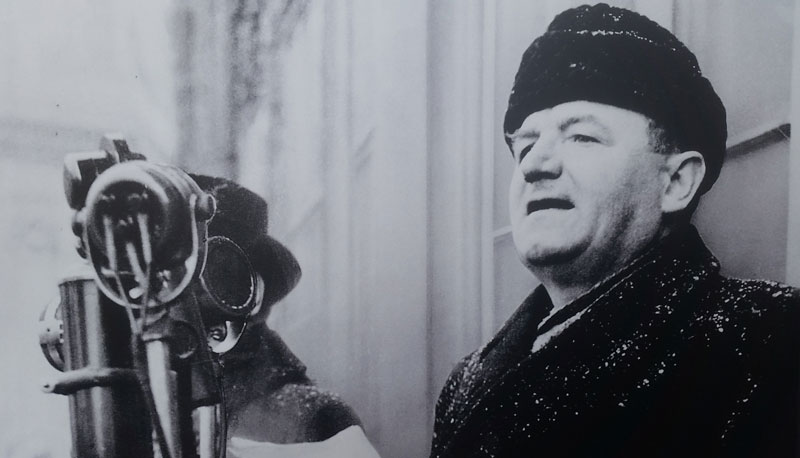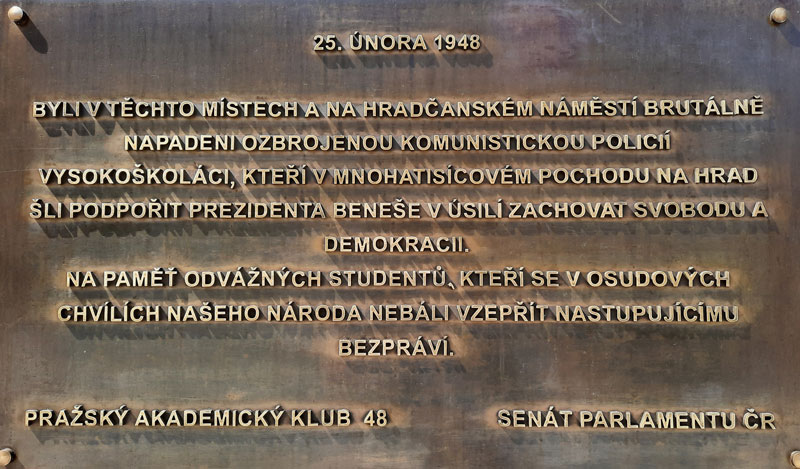1948 Communist Coup
All over this website on the historical and political posts as well as many of the attractions you’ll see me refer to the “Communist takeover” or the “Communist coup d’etat” which is still referred to historically as “Victorious February” by our local communist party. It’s worth taking some time to see where Czechoslovakia was in 1948, the characters involved in “Victorious February” and other factors that paved the way for the suspension of democracy for the next 42 years. And before any communists say “of course there was Democracy, there were elections”, I’ll say that having to vote for the one name on the sheet is not Democracy.

The Effect of World War One
Czechoslovakia only existed because of the defeat of the Austro-Hungarian Empire who had allied with Germany in the Great War. Remember that the present day Czech Republic had been under the control of the Empire but many Czechs wanted independence. By the last year of the war in 1918 they were fighting as the Czechoslovak Legion alongside Bolshevik (communist) Russian soldiers so it’s not surprising that socialist ideals were taking root. Probably the single biggest factor for the future post-1918 was that the new country needed a constitution and the authors of that document who had lived their whole lives under an Emperor were determined that the real power of government should lay with the elected Premier, not the President who should be more of a figurehead or moral authority. In the first free elections the Communist Party won @10% of the vote or 30 seats in the first parliament.
The Effect of World War Two
The Soviet Army were seen as liberators of the city in 1945 and around 30 different small political factions and unions joined with the Communist Party under the banner of the National Front Party. Klement Gottwald was named chairman of the National Front and became a deputy Premier in the post-war interim government.
In the 1946 elections the Communist Party ran under it’s own name and became the largest party in parliament taking 31% of the vote or 93 seats. Their leader Klement Gottwald would become Premier under the Czech Constitution on July 2nd 1946 and they held the government posts of Interior, Finance, Information and Social Welfare. The post of Defence Minister went to an independent called Ludvik Svoboda (who later aligned with the communists). Edvard Beneš was re-elected as President.
1947 – It Begins
Three big things happened 1947. The first was the rejection of the US Marshall Plan. Stalin wanted Czechoslovakia in the Russian sphere of influence and was already promoting the communist version of the Marshall Plan called the Council for Mutual Economic Assistance (COMECON).
The second was the creation of the SNB or National Security Corps which had criminal-police, quasi-military and security-police roles and reported direct to the Interior Ministry which was under communist leadership.
The third was a strong move by the communist against it’s political opponents including parcel-bombs sent in September 1947 to three non-communist government ministers. This was called the Krčman Affair and it shed a light on communist officials who had financed and arranged for the bombs to be made. The Interior Ministry began the Krčman investigation.
Victorious February Begins
On February Friday 13th 1948 things came to a head. The Interior Minister was due to give the interim report on the Krčman Affair and also to explain why he had replaced 8 high ranking SNB (Security Police) personnel with communist supporters. But he skipped the meeting so the non-communist majority part of the government passed a resolution requiring him to revoke the changes. This was called the “Security Resolution”.
February 17th
A meeting to discuss the “Security Resolution” was postponed because the Interior Minister was still absent. President Beneš weighed the idea of forming a caretaker government. The communists started to mobilise supporters.
February 19th
Thinking that the President will call for a caretaker government, a non-communist block of 12 government ministers stated that unless the “Security Resolution” was implemented they would resign. But President Beneš rejected the idea of a caretaker government without the communists involved.
February 20th
Premier Gottwald did not implement the Security Resolution so 12 non-communist ministers resigned hoping to force early elections. Klement Gottwald submitted his proposals for new appointees for the posts (all communist supporters). The communist supporting “People’s Militia” was now armed and began occupying state buildings.
February 21st

Klement Gottwald made a speech on the balcony of the Kinsky Palace on the Old Town Square calling for support from the public in the form of a General Strike (pictured). As you can see, the photo was edited so that only Klement Gottwald was visible.
February 23rd
The People’s Militia and SNB were now in control of significant state property and infrastructure. The communists began to arrest political opponents.
February 24th
The General Strike begins.
February 25th

On the morning of February 25th thousands of students were marching towards Prague Castle with the aim of appealing to President Beneš to restore order. The security police (SNB) backed up by the armed communist “People’s Militia” stopped them both at the square in front of the castle and on the street called Nerudova. The memorial plaque to this event pictured above is at the top of Nerudova on the right (before you turn to walk up the steep hill to the castle). Under pressure from the General Strike, armed insurrection, threat of civil war and a perceived Soviet intervention (turned out to be a false assumption), at 4-15pm President Beneš formally accepted the government resignations from February 20th and their communist replacements. Gottwald went to Wenceslas Square and made his “Victorious February” speech.
March 10th
Foreign Minister Jan Masaryk was found dead in his pyjamas having apparently fallen out of his 4th floor window at the Černín Palace Foreign Ministry.
March 11th
The new communist dominated government was sworn in.
May 9th
A new constitution was proposed by the government but President Beneš refused to sign it.
May 30th
Elections are held but people could only vote for Communist Party approved candidates.
June 2nd
President Beneš resigned.
June 14th
Klement Gottwald became President and 42 years of communist rule began.
